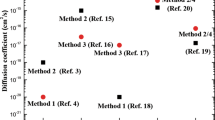Abstract
Diffusivity of sodium in molten tin was determined using an electrochemical cell of the type Na/Na-β″-Al2O3/(Na)Sn where Na-β″-Al2O3, which is a sodium-ion conductor, was the solid electrolyte. Using the above cell in which a small amount of sodium dissolved in tin was transported through β″-Al2O3 upon application of an external voltage, and using a known solution to Fick's second law for appropriate boundary conditions, the diffusivity was determined to be
withQ = 16320 J mol−1 over a range of temperatures from 240 to 440° C. From the solution to Fick's second law, it was shown that first term approximations, which have often been used in the past, lead to an estimate of diffusivity which is about a factor of 2 too high indicating that more terms should be considered. The diffusivity was also determined using a transient technique in which the decay in voltage upon removal of externally applied voltage was recorded as a function of time. The diffusivity so determined, in which it was assumed that the only polarization was the concentration polarization, was higher than the previous method. The difference between the two diffusivities became smaller with increasing temperature. These experiments thus suggested that interfacial or activation polarization must also be present.
Similar content being viewed by others
References
R. E. Meyer andN. H. Nachtrieb,J. Chem. Phys. 23 (1955) 1851.
C. Potard, A. Teiller andP. Dusserre,Mater. Res. Bull. 7 (1972) 583.
H. Rickert andA. A. El Miligy,Z. Metallk. 59 (1968) 635.
T. A. Ramanarayan andR. A. Rapp,Met. Trans. 3 (1972) 3239.
S. Otsuka andZ. Kozuka,ibid. 6B (1975) 389.
S. Otsuka, M. Matsuyama andZ. Kozuka,ibid. 9B (1978) 21.
D. O. Raleigh andH. R. Crowe,J. Electrochem. Soc. 116 (1969) 40.
K. B. Oldham andD. O. Raleigh,ibid. 118 (1971) 252.
J. T. Kummer andN. Weber,Soc. Automot. Eng. Trans. 76 (1968) 1003.
N. Weber,Energy Covers. 14 (1974) l.
J. T. Jummer,Prog. Solid State Chem. 7 (1972) 141.
G. C. Farrington andB. Dunn,Solid State Ionics 7 (1982) 267.
G. E. Youngblood, A. V. Virkar, W. R. Cannon andR. S. Gordon,Bull Amer. Ceram. Soc. 56 (1977) 206.
J. Crank, “The Mathematics of Diffusion”, 4th edn (Oxford Press, 1967).
R. V. Churchill, “Operational Mathematics in Engineering” (McGraw-Hill, New York, London, 1944) p. 205.
J. B. Edward, E. E. Hücke andJ. J. Martin,J. Electrochem. Soc. 115 (1968) 488. (1968) 488.
Author information
Authors and Affiliations
Rights and permissions
About this article
Cite this article
Oakeson, D., Virkar, A.V. Determination of diffusivity of sodium in liquid tin using Na-ß″ alumina. J Mater Sci 19, 213–222 (1984). https://doi.org/10.1007/BF02403128
Received:
Accepted:
Issue Date:
DOI: https://doi.org/10.1007/BF02403128




